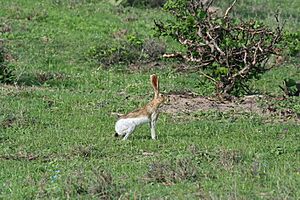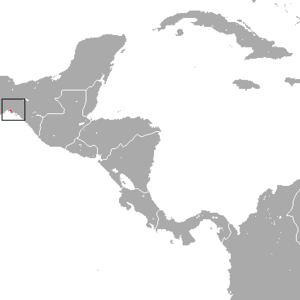Tehuantepec jackrabbit facts for kids
Quick facts for kids Tehuantepec jackrabbit |
|
|---|---|
 |
|
| Conservation status | |
| Scientific classification | |
| Genus: |
Lepus
|
| Species: |
flavigularis
|
 |
|
| Tehuantepec jackrabbit range | |
The Tehuantepec jackrabbit (Lepus flavigularis) is a special type of jackrabbit. It lives only in Mexico. This makes it an endemic animal, meaning it is found nowhere else in the world.
Contents
What Does It Look Like?
This jackrabbit is easy to spot! It has two black stripes that go from the bottom of its ears to the back of its neck. Its sides are white, and its belly is also white. The top part of its body is a bright brown color mixed with black. Its rump (backside) is gray, and its tail is black.
The Tehuantepec jackrabbit is one of the biggest jackrabbits. It has large ears and long legs. Adult jackrabbits usually weigh about 3.5 to 4 kilograms. That's like carrying a small bag of groceries!
Where Does It Live?
The Tehuantepec jackrabbit is very rare. It lives only in the state of Oaxaca, Mexico. You can find it in savannas and grassy dunes. These areas are near the shores of a salty lagoon that connects to the Gulf of Tehuantepec. This region is called the Istmo de Tehuantepec.
Today, there are only three small groups of these jackrabbits left. They live separately from each other. Long ago, they might have lived in a larger area. This area stretched along the Mexican Pacific Coast. It went from Salina Cruz in Oaxaca to Tonalá in Chiapas. This whole area was probably about 5,000 square kilometers.
Its Home and Daily Life
Tehuantepec jackrabbits like to live in tropical dry savannas. These savannas have native grasses like Bouteloua and Paspalum. They also have scattered bushes like nanche (Byrsonima crassifolia) and trees like morro (Crescentia).
You can also find them in grassy areas along the coast. These places have special plants like Opuntia decumbens, Opuntia tehuantepecana, and Sabal mexicana.
Each jackrabbit has a home area of about 50 hectares. This is where it spends its time. These home areas can overlap with other jackrabbits. The jackrabbit is mostly active at night (nocturnal) and during dawn and dusk (crepuscular). During the day, it rests in hidden spots under bushes or tall grasses.
Other animals live in the same areas as the jackrabbit. These include the eastern cottontail rabbit, the nine-banded armadillo, and different kinds of skunks. There are also Virginia opossums, gray mouse opossums, gray foxes, common raccoons, and coyotes. The gray fox and the coyote are natural predators of the Tehuantepec jackrabbit.
Reproduction and Life Cycle
The Tehuantepec jackrabbit has a polygynous mating system. This means one male may mate with several females. Their breeding season can last for a long time, from February to December. They have the most babies during the rainy season, which is from May to October.
A female jackrabbit can have one to four babies at a time. Scientists are still studying how many litters a female can have in one year.
Why It Needs Our Help
The Tehuantepec jackrabbit is a very important animal. It is listed as critically endangered in Mexico. The International Union for Conservation of Nature (IUCN) also calls it an endangered species. This means it is at a very high risk of disappearing forever.
What Harms the Jackrabbit?
Many things threaten the Tehuantepec jackrabbit. Their homes are being lost or broken up into smaller pieces. People sometimes hunt them, even though it's not allowed. Their populations are also very small, which makes it harder for them to survive.
Here are some specific threats:
- Habitat Loss: New grasses that are not native are growing. There are also frequent fires, farming, and cattle raising. New human homes are also being built. All these things hurt the natural plants and homes of the jackrabbits.
- Hunting: Some people from nearby towns might hunt these jackrabbits. This can quickly reduce their numbers.
- Natural Predators: The gray fox and the coyote are natural hunters of the jackrabbit. They are a main reason why some jackrabbits die.


